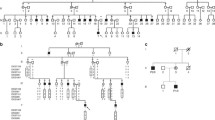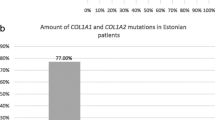Abstract
Osteogenesis imperfecta (OI) is a result of heterozygous mutations in the COL1A1 or COL1A2 genes, encoding type I procollagen chains. Here we described the molecular and biochemical defects detected in a case of severe type III OI. Cultured skin fibroblasts from the proband produced both normal and mutant type I collagen which was secreted into the medium. The mutation site was localized in α1(I)-CB3 by CNBr cleavage of collagen chains. Subsequent reverse transcription-PCR amplification and direct sequencing of single-stranded PCR product led to identification of G to A transition in the COL1A1 gene, resulting in Gly511Ser substitution in the a1 chain of type I collagen. The new mutation conforms to the chain-specific non-lethal microdomain of Gly to Ser substitutions in the genotype-phenotype map.
We have found that biosynthesis of collagen was increased in OI cells to about 160% of the control value. However, the amount of collagen deposed to the insoluble matrix was decreased as compared to the control. This suggests increased degradation of collagen, since the collagenolytic activity of OI cells was increased. Furthermore, the activity of prolidase, which is a marker of collagen turnover, was increased in OI cells. In regulation of activity of the enzyme are involved β1 integrin and insulin-like growth factor (IGF) receptors. Western immunoblot analysis showed that the expressions of both receptors were markedly increased in OI cells. These results suggest that increase in activity of prolidase can be associated with increase in intensity of collagen metabolism in type III OI patient with identified new G511S mutation.
Similar content being viewed by others
References
Sillence DO, Senn A, Danks DM: Genetic heterogeneity in osteogenesis imperfecta. J Med Genet 16: 101-116, 1979
Prockop DJ: Mutations in collagen genes as a cause of connective-tissue diseases. N Engl J Med 326: 540-546, 1992
Byers PH: Disorders of collagen biosynthesis and structure. In: C.R. Scriver, A.L. Beaudet, W.S. Sly, D. Valle (eds). The Metabolic Basis of Inherited Disease. McGraw Hill, New York, 1989, pp 2805-2842
Dalgleish R: The human type I collagen database. Nucleic Acids Res 25: 181-187, 1997
Cole WG: The molecular pathology of osteogenesis imperfecta. Clin Orthop Rel Res 343: 235-248, 1997
Jackson SH, Dennis AN, Greenberg M: Iminopeptiduria. A genetic defect in recycling collagen; a method for determining prolidase in red blood cells. Can Med Ass J 113: 759-763, 1975
Phang JM, Scriver CR: Disorders of proline and hydroxyproline metabolism. In: C.R. Scriver, A.L. Beaudet, W.S. Sly, D. Valle (eds). The Metabolic Basis of Inherited Disease. McGraw Hill, New York, 1989, pp 577-597
Yaron A, Naider F: Proline-dependent structural and biological properties of peptides and proteins. Crit Rev Biochem Mol Biol 28: 31-81, 1993
Emmerson KS, Phang JM: Hydrolysis of proline dipeptides completely fulfills the proline requirement in a proline-auxotropic Chinese Hamster Ovary cell line. J Nutr 123: 909-914, 1993
Bonadio J, Holbrook KA, Gelinas RE, Jacob J, Byers PH: Altered triple helical structure of type I procollagen in lethal perinatal osteogenesis imperfecta. J Biol Chem 260: 1734-1742, 1985
Laemmli UK: Cleavage of structural proteins during the assembly of the head of bacteriophage T4. Nature (Lond) 227: 680-685, 1970
Chomczynski P, Sacchi N: Single step method of RNA isolation by acid guanidium thiocyanate-phenol-chloroform extraction. Anal Biochem 162: 156-159, 1987
Sanger F, Nicklin S, Coulson AR: DNA sequencing with chain terminating inhibitors. Proc Natl Acad Sci USA 74: 5463-5467, 1997
Oyamada I, Pałka J, Schalk EM, Takeda K, Peterkofsky B: Scorbutic and fasted guinea pig sera contain an insulin-like growth factor-I reversible inhibitor of proteoglycan and collagen synthesis in chick embryo chondrocytes and adult human skin fibroblasts. Arch Biochem Biophys 276: 85-93, 1990
Peterkofsky B, Chojkier M, Bateman J: Determination of collagen synthesis in tissue and cell culture system. In: M. Furthmay (ed). Immunochemistry of the Extracellular Matrix. CRC Press, Boca Raton, Fl, 1982, pp 19-47
Myara I, Charpentier C, Lemonnier A: Optimal conditions for prolidase assay by proline colorimetric determination: Application to imidodipeptiduria. Clin Chim Acta 125: 193-205, 1982
Chinard FP: Photometric estimation of proline and ornithine. J Biol Chem 199: 91-95, 1952
Lowry OH, Rosenbergh NI, Farr AL, Randall IR: Protein measurement with the folin reagent. J Biol Chem 193: 265-275, 1951
Unemori EN, Werb Z: Reorganization of polymerized actin: A possible trigger for induction of procollagenase in fibroblasts cultured in and on collagen gels. J Cell Biol 103: 1021-1031, 1986
Miltyk W, Karna E, Wołczyński S, Pałka J: Insulin-like growth factor-I-dependent regulation of prolidase activity in cultured human skin fibroblasts. Mol Cell Biochem 189: 177-184, 1998
Pałka JA, Phang J: Prolidase activity in fibroblasts is regulated by interaction of extracellular matrix with cell surface integrin receptors. J Cell Biochem 67: 166-175, 1997
Marini JC, Lewis MB, Wang Q, Chen KJ, Orrison BM: Serine for glycine substitutions in type I collagen in two cases of type IV osteogenesis imperfecta (OI). Additional evidence for a regional model of OI pathophysiology. J Biol Chem 268: 2667-2673, 1993
Scott JE: Proteoglycan-fibrillar collagen interactions. Biochem J 252: 313-323, 1988
Pepin M, Atkinson M, Starman BJ, Byers PH: Strategies and outcomes of prenatal diagnosis for osteogenesis imperfecta: A review of biochemical and molecular studies completed in 129 pregnancies. Prenat Diagn 17: 559-570, 1997
Mottes M, Gomez Lira M, Zolezzi F, Valli M, Lisi V, Freising P: Four new cases of lethal osteogenesis imperfecta due to glycine substitutions in COL1A1 and genes. Hum Mutat 12: 71-72, 1998
Ward LM, Lalic L, Roughley PJ, Glorieux FH: Thirty-three novel COL1A1 and COL1A2 mutations in patients with osteogenesis imperfecta types I–IV. Hum Mutat 17: 434, 2001
Mackay K, Byers PH, Dalgleish R: An RT-PCR-SSCP strategy for detection of mutations in the gene encoding the alpha 1 chain of type I collagen: Application to four patients with osteogenesis imperfecta. Hum Mol Genet 2: 1155-1160, 1993
Rose NJ, Mackay K, De Paepe A, Steinmann B, Punnett HH, Dalgleish R: Three unrelated individuals with perinatally lethal osteogenesis imperfecta resulting from identical Gly502Ser substitution in the alpha 2-chain of type I collagen. Hum Genet 94: 497-503, 1994
Galicka A, Wołczyński S, Anchim T, Surażyński A, Lesniewicz R, Pałka J: Defects of type I procollagen metabolism correlated with decrease of prolidase activity in a case of lethal osteogenesis imperfecta. Eur J Biochem 268: 2172-2178, 2001
Miltyk W, Karna E, Pałka J: Inhibition of prolidase activity by nonsteroid antiinflammatory drugs in cultured human skin fibroblasts. Pol J Pharmacol 48: 609-613, 1996
Pałka J, Miltyk W, Karna E, Wołczyński S: Modulation of prolidase activity during in vitro aging of human skin fibroblasts the role of extracellular matrix collagen. Tokai J Exp Clin Med 21: 207-213, 1996
Pałka JA, Karna E, Miltyk W: Fibroblast chemotaxis and prolidase activity modulation by insulin-like growth factor II and mannose 6-phosphate. Mol Cell Biochem 168: 177-183, 1997
Miltyk W, Pałka JA: Potential role of pyrroline 5-carboxylate in regulation of collagen biosynthesis in cultured human skin fibroblasts. Comp Biochem Physiol (part A) 125: 265-271, 2000
Myara I, Miech G, Fabre M, Mangeot M, Lemonnier A: Changes in prolinase and prolidase activity during CCl4 administration inducing liver cytolysis and fibrosis in rat. Brit J Exp Pathol 68: 7-13, 1987
Author information
Authors and Affiliations
Rights and permissions
About this article
Cite this article
Galicka, A., Wołczyński, S., Gindzienński, A. et al. Gly511 to Ser substitution in the COL1A1 gene in osteogenesis imperfecta type III patient with increased turnover of collagen. Mol Cell Biochem 248, 49–56 (2003). https://doi.org/10.1023/A:1024197213525
Issue Date:
DOI: https://doi.org/10.1023/A:1024197213525




